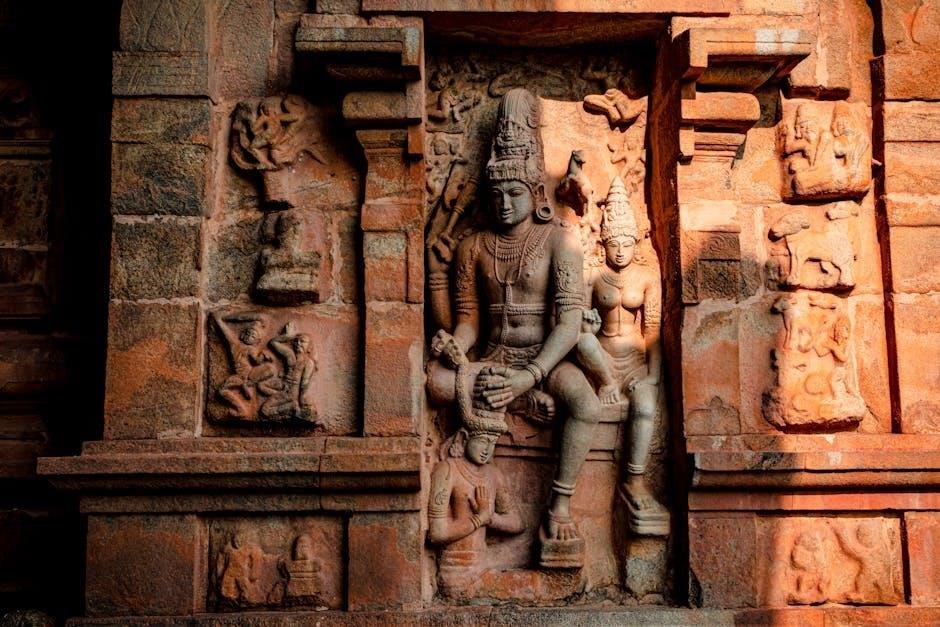Shiva Panchakshari Stotram: An Overview
The Shiva Panchakshari Stotram is a revered hymn dedicated to Lord Shiva. This sacred composition praises Shiva through the potent “Na-Ma-Shi-Va-Ya” mantra. The stotram highlights Shiva’s qualities and significance. It encapsulates devotion and seeks blessings. The stotram is available in PDF format online.
Significance of the Shiva Panchakshari Mantra
The Shiva Panchakshari Mantra, embodied within the Shiva Panchakshari Stotram, holds profound significance in Hinduism. It is a powerful invocation of Lord Shiva, representing the essence of the universe and the divine self. Reciting this mantra is believed to purify the mind, body, and soul, leading to spiritual awakening and liberation.
Each syllable of the mantra, “Na-Ma-Shi-Va-Ya,” carries deep meaning and represents different aspects of Lord Shiva. “Na” represents the earth element, “Ma” represents water, “Shi” represents fire, “Va” represents air, and “Ya” represents ether. Together, these syllables symbolize the five elements that constitute the universe and are controlled by Shiva.
The mantra is considered a potent tool for connecting with Shiva’s divine energy, offering protection, and attaining inner peace. Devotees believe that chanting with sincerity and devotion can remove obstacles, grant blessings, and lead to self-realization. The availability of the Shiva Panchakshari Stotram in PDF format makes it easily accessible, allowing individuals to incorporate this powerful mantra into their daily spiritual practice and deepen their connection with the divine. Reciting the mantra with understanding and devotion amplifies its transformative effects. The mantra’s simplicity belies its profound impact on one’s spiritual journey, making it a cornerstone of Shiva worship.
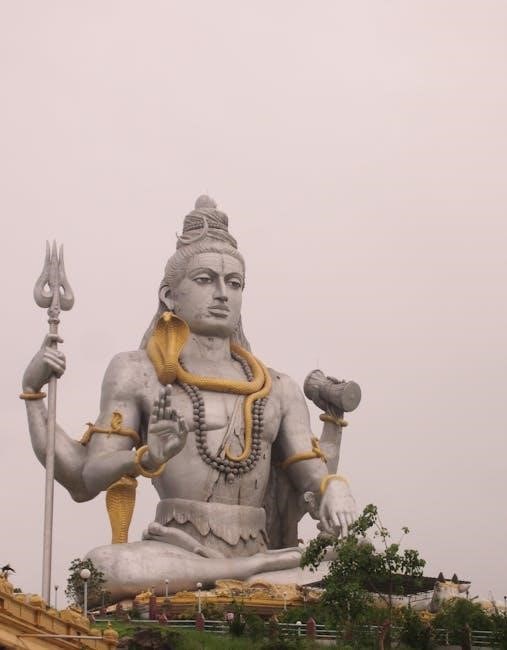
The Five Syllables: Na-Ma-Shi-Va-Ya
The mantra “Na-Ma-Shi-Va-Ya,” central to the Shiva Panchakshari Stotram, comprises five sacred syllables, each laden with profound spiritual significance. These syllables are not mere sounds; they represent fundamental aspects of existence and the divine qualities of Lord Shiva. Understanding their individual meanings enhances the mantra’s potency during recitation.
“Na” symbolizes the earth element, representing groundedness, stability, and the physical body. It signifies Shiva’s aspect as the foundation of creation. “Ma” embodies the water element, associated with fluidity, emotions, and the subconscious mind. It reflects Shiva’s compassionate nature and his ability to dissolve negativity.
“Shi” represents the fire element, symbolizing transformation, energy, and purification. It signifies Shiva’s power to destroy illusions and ignite spiritual growth. “Va” embodies the air element, associated with movement, breath, and communication. It reflects Shiva’s all-pervading presence and his ability to connect with devotees.
“Ya” represents the ether element, symbolizing space, consciousness, and the divine self. It signifies Shiva’s ultimate reality as the supreme consciousness that transcends all limitations. Together, these five syllables encapsulate the entirety of existence and represent the multifaceted nature of Lord Shiva. Chanting “Na-Ma-Shi-Va-Ya” is a journey through the elements, leading to a deeper understanding of oneself and the divine.
Shiva Panchakshari Stotram in Sanskrit
The Shiva Panchakshari Stotram, deeply rooted in Hindu tradition, is traditionally recited in Sanskrit. The Sanskrit version carries a unique resonance, attributed to the language’s ancient origins and its meticulous structure. Each verse is crafted to evoke specific emotions and insights, enhancing the spiritual experience for the devotee.
The Sanskrit rendition begins with the powerful invocation, “Om Namah Shivaya,” setting a tone of reverence and surrender. The subsequent verses beautifully describe Shiva’s attributes, such as his adornment with the King of Snakes (“Nagendra Haaraya”) and his three eyes (“Trilochanaya”). The rhythmic flow and carefully chosen words amplify the hymn’s potency.
Devotees often seek the Sanskrit text to ensure accurate pronunciation, believing it to be crucial for maximizing the mantra’s benefits. The availability of the Stotram in PDF format allows for easy access to the original Sanskrit verses. Reciting or even reading the Stotram in Sanskrit is considered a sacred act, fostering a deeper connection with Lord Shiva. The vibrations produced by the Sanskrit sounds are believed to purify the mind and awaken spiritual consciousness. The Sanskrit version remains the most cherished form of this powerful hymn.
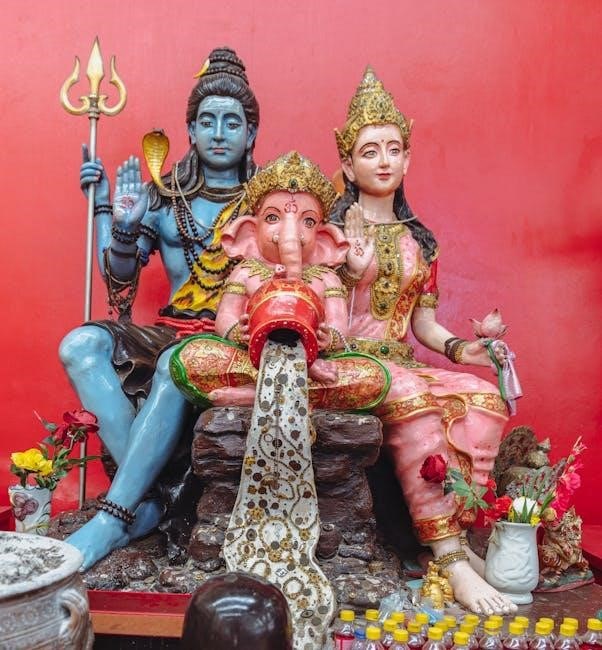
Shiva Panchakshari Stotram with English Transliteration
To cater to a wider audience, the Shiva Panchakshari Stotram is often presented with English transliteration. This allows individuals unfamiliar with the Sanskrit script to pronounce the verses accurately and participate in the recitation. The transliteration aims to capture the phonetic sounds of the Sanskrit words using the English alphabet.
The English transliteration typically follows a standardized system, such as IAST (International Alphabet of Sanskrit Transliteration), to ensure consistency and accuracy. This system uses diacritics to represent sounds that do not have direct equivalents in English. For instance, “nā” represents the long “a” sound.
Providing the transliteration alongside the Sanskrit text makes the Stotram more accessible to those who wish to learn and understand the correct pronunciation. It bridges the gap between the ancient language and contemporary readers, enabling them to engage with the hymn on a deeper level. Many resources offer the Shiva Panchakshari Stotram in PDF format, including both the Sanskrit verses and their English transliteration. This combination facilitates learning and recitation, fostering a connection with the divine through sound and devotion.
Shiva Panchakshari Stotram with English Translation
To fully grasp the essence and significance of the Shiva Panchakshari Stotram, an English translation is invaluable. The translation unveils the meaning behind the Sanskrit verses, allowing devotees to connect with the hymn on an intellectual and emotional level. It transforms the recitation from a mere repetition of sounds into a profound understanding of Lord Shiva’s attributes and glories.
Each verse of the Stotram is carefully translated to convey its intended message. The translations often capture the poetic beauty and devotional fervor of the original Sanskrit; They explain the symbolism and imagery used to describe Lord Shiva, such as his association with the Mandakini river, his adornment with snakes, and his three eyes.
By providing an English translation alongside the Sanskrit text and transliteration, the Shiva Panchakshari Stotram becomes accessible to a wider audience, regardless of their familiarity with Sanskrit. This inclusivity enables individuals from diverse backgrounds to appreciate the hymn’s profound message and experience its transformative power. Many online resources and PDF documents offer the Stotram with a clear and accurate English translation, making it easy for anyone to delve into its spiritual depths. The integration of translation allows devotees to internalize the prayers effectively.
Benefits of Reciting the Shiva Panchakshari Stotram
Reciting the Shiva Panchakshari Stotram is believed to bestow numerous spiritual and worldly benefits. The stotram, centered around the sacred mantra “Na-Ma-Shi-Va-Ya”, is considered a powerful tool for connecting with Lord Shiva and invoking his blessings. Regular recitation is said to purify the mind, body, and soul, leading to inner peace and tranquility.
One of the primary benefits is the removal of obstacles and negative energies. Lord Shiva, as the destroyer of illusions, is invoked to clear the path for spiritual progress. The stotram is believed to dissolve karmic debts, alleviate suffering, and grant protection from harm. Devotees often experience a sense of strength and resilience in the face of challenges.
Furthermore, reciting the Shiva Panchakshari Stotram is thought to enhance devotion, wisdom, and spiritual insight. It cultivates a deeper understanding of Lord Shiva’s nature and his role in the universe. The stotram fosters a sense of surrender and acceptance, allowing devotees to align themselves with divine will. It leads to improvements in overall well-being. Accessing the Stotram in PDF format further simplifies the practice, enabling regular and convenient recitation.
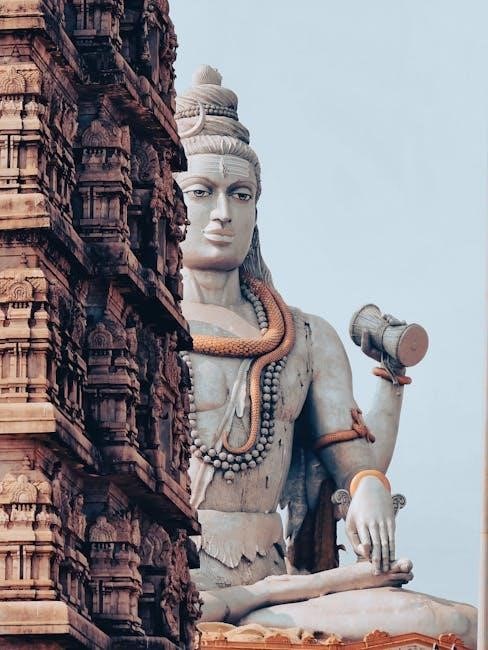
Adi Shankaracharya and the Shiva Panchakshari Stotram
Adi Shankaracharya, the renowned philosopher and theologian, is deeply connected with the Shiva Panchakshari Stotram. He is highly regarded as a major proponent of Advaita Vedanta. The stotram, a hymn dedicated to Lord Shiva, resonates with Shankaracharya’s teachings on the formless, attributeless Brahman. While the exact authorship is debated, it’s associated with him due to its philosophical alignment.
Shankaracharya’s works often emphasized the importance of devotion and contemplation as paths to self-realization. The Shiva Panchakshari Stotram, with its simple yet profound verses, serves as a powerful tool for both. By chanting the mantra “Na-Ma-Shi-Va-Ya”, devotees can focus their minds and connect with the divine essence of Shiva. This aligns with Shankaracharya’s teachings on realizing one’s true nature.
The stotram, available in PDF format, allows devotees to easily access and study the verses. Shankaracharya’s influence can be seen in the stotram’s wide acceptance and use in various spiritual practices. It is a testament to his lasting legacy and his ability to synthesize complex philosophical concepts into accessible devotional forms.
Availability of Shiva Panchakshari Stotram in PDF Format
The Shiva Panchakshari Stotram, a revered hymn dedicated to Lord Shiva, is widely accessible in PDF format across numerous online platforms. This digital availability makes it incredibly convenient for devotees to access, download, and study the stotram at their leisure. The PDF format ensures that the text remains consistent across different devices, preserving the integrity of the sacred verses.
Several websites dedicated to Hindu scriptures, devotional literature, and spiritual resources offer free PDF downloads of the Shiva Panchakshari Stotram. These PDFs often include the original Sanskrit text, transliterations in various languages, and English translations. Some versions may also include audio recordings of the stotram being chanted, enhancing the learning and devotional experience.
The widespread availability in PDF format is instrumental in promoting the stotram’s reach and popularity. Individuals can easily print copies for personal use, study groups, or distribution within their communities. This accessibility ensures that the sacred verses of the Shiva Panchakshari Stotram continue to inspire and uplift devotees worldwide, fostering a deeper connection with Lord Shiva.
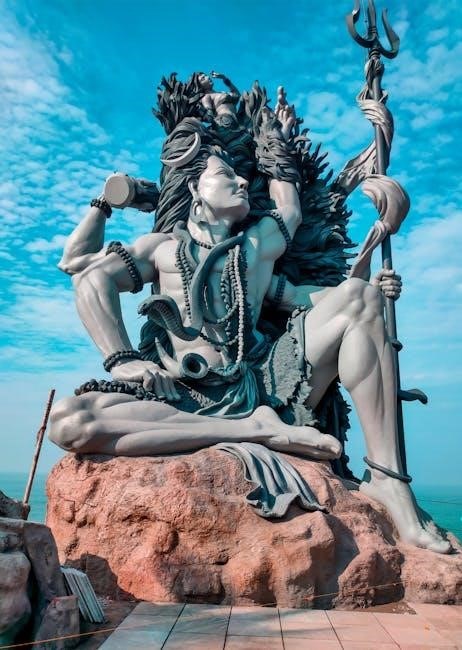
Shiva Panchakshari Stotram in Various Languages
The Shiva Panchakshari Stotram, a powerful hymn dedicated to Lord Shiva, transcends linguistic barriers and is available in a multitude of languages. This widespread translation and transliteration make it accessible to a global audience, fostering a deeper understanding and appreciation for its profound message.
Devotees can find the stotram in various Indian languages such as Hindi, Telugu, Tamil, Kannada, Malayalam, Gujarati, Bengali, and Oriya. These versions often include the original Sanskrit verses alongside translations or transliterations in the respective regional script. This allows individuals to connect with the stotram in their native tongue, enhancing their devotional experience.
Furthermore, the Shiva Panchakshari Stotram is also available in English, both as a translation and a transliteration. The English translation provides a clear understanding of the stotram’s meaning, while the transliteration allows individuals unfamiliar with Sanskrit to pronounce the verses accurately. The availability of the stotram in multiple languages ensures that it remains a source of inspiration and solace for devotees from diverse cultural backgrounds around the world. This linguistic diversity enriches the stotram’s global appeal.
